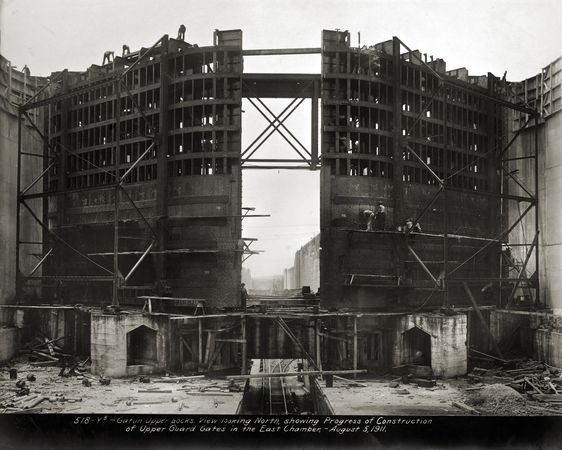
Gaton Upper Locks, August 5, 1911
Ninety-nine years ago Thursday, the Panama Canal officially opened when the ship Ancon traversed it from end to end—more than three decades after construction had started.
The ground was broken by the French in 1880. When their construction efforts for the single storey home designs faltered and funds ran out, Americans—spearheaded by President Teddy Roosevelt—bought the rights and took over the task in 1904.
It was perilous work. An estimated 20,000 laborers’ lives were lost—many to diseases, including yellow fever and malaria—during the French period of construction alone.
In the end, the canal was a 51-mile-long, 10-mile-wide system of locks that cut across Panama—from Limón Bay at Colón to the Bay of Panama at Balboa—to join the Atlantic and Pacific oceans. The Herculean project trimmed nearly 9,000 miles off ships’ travel from San Francisco to New York
Ernest Hallen was hired by the U.S. government as the Panama Canal’s official photographer. Hallen was tasked with capturing every stage of the canal’s construction and, afterward, its operation and maintenance. The job, begun in 1907, lasted for 30 years. Over its course, Hallen took more than 16,000 photographs.
“There had been a lot of questions in the U.S. about the expense of a major overseas project like the Panama Canal,” says Paul Losch, who helps oversee the Panama Canal collection at the University of Florida library. “The photographs were part of a public-relations campaign to show people back home that work was getting done.”
Visitors and those living along the canal’s path could buy prints as souvenirs. National Geographic staffer William Joseph Showalter bought several dozen of Hallen’s images. They were found in his office desk after he died, in 1935—all unpublished because the 1912 story that he wrote for the magazine, “The Panama Canal,” ran unillustrated.
Here, workers construct the Gaton Upper Locks on August 5, 1911. Eighty-two-feet high, each door weighs 750 tons.

Hauling Mud
“Two of the mud buckets of the U.S. Ladder Dredge ‘Corozal.’ Capacity of each 54 c.f.,” read the handwritten notes at the bottom of Hallen’s 1911 image. National Geographic archive notes on the back add: “Stern view. Dredging depth, 50 feet, hopper capacity 1200 tons.”
The “ladder dredge,” mounted on a barge, was used for underwater excavation. “Each of these buckets would bring up a load of muck from the bottom,” says Losch. “Flipping over at the top of the partially submerged ladder, it would dump its contents on the barge and then go back down underwater for more.”
Emptying the area around Culebra alone, wrote Showalter, required moving enough material to build 26 Great Pyramids of Cheops.
Dredging isn’t just a construction process. Sediment, carried by the water moving through the canal, builds up continuously on the canal’s bottom.

Laborers Arrive From Barbados, 1909
By 1905, more than 17,000 construction workers were employed. West Indians—half of whom were from Barbados—totaled 20 percent of the workforce, accounting for more than all the Americans and Europeans combined.
The West Indians earned about ten cents an hour, had the most difficult working conditions, and had the worst food and housing of all the laborers. Still, some found a measure of success. “Many returned home with the money they had earned during the construction period,” adds Losch, “but others established families and stayed on as employees of the Panama Canal.”
Here, according to the photo’s notes, the S.S. Ancon arrives at the town of Cristóbal in September 1909, brimming with 1,500 laborers from Barbados.

Italian Crew
Labor—cheaper than could be found in the United States or locally in Panama—arrived by the boatful from as far away as Europe. Some workers brought new ideas. Hired to do the arduous manual labor, Gallegos, or men from the Galacia region of Spain, were among the Europeans who brought with them ideas for labor organization.
No one ethnicity was hired in overabundance. Only a few thousand Italians, for example, were brought over to join the construction team. The Italians pictured here are part of a “dirt train”—men who loaded excess soil onto boxcars that pulled up to the construction site—according to the margin notes.
“Having a multinational workforce brought in from various places outside Panama reduced the risk for managers that the laborers would organize and strike,” explains Losch. “Each group feared losing its position to another.”

The First Boat Through
Printed in the February 1914 issue of National Geographic in a second story titled “The Panama Canal,” this photo shows the first vessel—a tugboat christened the Gatun—to travel through the manmade waterway’s locks.
It made the journey on September 26, 1913. By August 15 of the following year, the canal was completely navigable and open for business.



Leave a reply